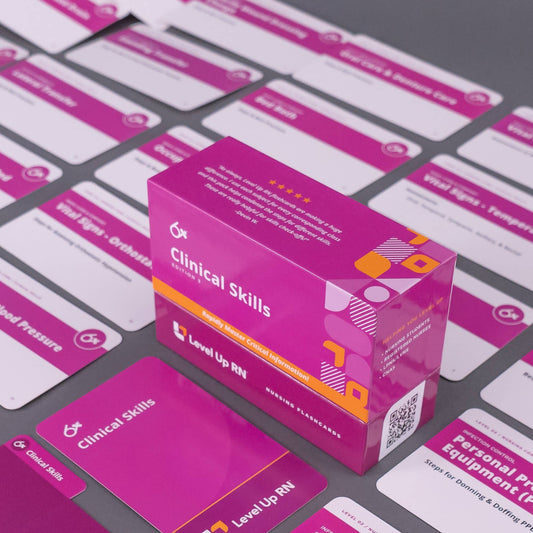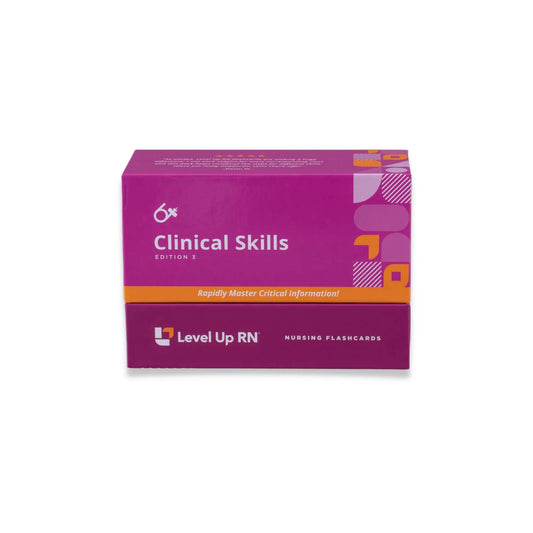Clinical Skills - Intradermal, Subcutaneous, and Intramuscular Injections
Updated: Ellis ParkerA demonstration on how to administer an intradermal, subcutaneous, and intramuscular injection.
Full Transcript: Clinical Skills - Intradermal, Subcutaneous, and Intramuscular Injections
Full Transcript: Clinical Skills - Intradermal, Subcutaneous, and Intramuscular Injections
Hi, I'm Ellis with Level Up RN. In this video, I'll be demonstrating how to perform injections. I'll be doing intradermal injections, subcutaneous injections, and intramuscular injections. I'll be following along on the steps that are included in our Clinical Nursing Skills deck. So if you have the deck, grab these cards. If you don't have the deck, head on over to LevelUpRN.com to check one out.
Intradermal injections are almost always done on the forearm, so that's what we'll be practicing with today. So after you select your site, you're going to clean it with an antiseptic swab, starting in the center and moving out. And as that's drying, I'm going to go ahead and grab my syringe. So I'm always going to use a very small gauge needle. I'm going to position it so that the bevel is up. I want the bevel up because for intradermal injections, I want the bleb to form, which can also be called a wheal or a bubble, right? When you get that TB shot, you've got that little bubble that forms. If my bevel is not up, which allows the medication to be injected up into that first layer of tissue, if the bevel is down and I inject the medication down, it won't form the bleb that I'm looking for. So with my bevel up and with my hands kind of high on the syringe itself-- meaning I don't want to grip it really low. I don't want to hold it like a dart like I would for an IM. I want to hold it rather high because I need to go at a really low angle, and I don't want my fingers in the way.
So I'm going to pull the skin taut with my thumb and forefinger of my nondominant hand. Holding my syringe with my fingers on top of it with my bevel up, I'm going to inject at a 5- to 15-degree angle slightly under that skin. Once the full bevel is under the skin, I can then inject the medication, hoping for that bleb to form. And mine is not really cooperating. Once that's done, I withdraw it at the same angle. And with these, it's really imperative that I do not massage the site in any way because then that might disperse that medication into different layers of tissue. And that's how I do my intradermal injection.
In preparing for my subcutaneous injections, I've already done my hand hygiene and donned gloves. I then need to select the site that I'm going to be using, and this can be any site that has a surplus of subcutaneous tissue or fatty tissue, right? So the most common areas are going to be on your tummy, so I've got my little belly friend here today. So on your tummy, on the backs of your arms is good, although difficult to do to yourself. And then the lateral aspects of your thighs can also be an option. So we'll be using the abdomen today. I've already gotten an insulin needle drawn up with some insulin. So I'm just going to go ahead and use an antiseptic swab to clean in a circular motion starting where my injection is outward and allow that to dry. If my patient has at least one inch of pinchable fat, meaning they've got a little bit extra going on, then I can go in at a 90-degree angle. If they do not have the extra subcutaneous fat, then I am going to want to go in at a lower angle, at a 45-degree angle, because if they are not blessed with extra subcutaneous tissue and you go in at a 90-degree angle, you have an increased likelihood of hitting that muscle. You don't want the needle to go into the muscle. This medication is for subcutaneous injections. So you might want to decrease that insertion angle if that's needed.
So I uncapped my needle. I'm actually going to pinch the subcutaneous tissue up, which is, again, a little bit difficult on these mannequins. But as well as I can, I'm going to pinch it up. I'm going to go ahead and do a 45-degree angle for this guy. So I'm going to insert my needle. I'm going to let go of the pinch. I'm going to inject my medication and then take the needle out at the same angle that I inserted it. I then immediately waste this needle into my sharps box, and then I can apply a piece of gauze or a bandage if needed. But like all of my other insertable medications, I do not massage the site. I just let it be. And he's gotten his insulin.
My first demonstration of an intramuscular injection is going to be in the vastus lateralis site, and I'm going to be using just the general injection method. So I've got my patient here. This is his rear end, right? I'm going to locate my site using those anatomical landmarks. So I'm going to place the palm of my hand on the greater trochanter. I'm going to point my middle finger straight up towards his iliac crest. I'm going to dip my first finger forward towards his groin. And this is my triangle of safety. So this is where I would want to inject my medication. So once I determine the injection site, I'm going to get a antiseptic swab. I'm going to go in concentric circles. And as that's drying, I'm going to grab my syringe and needle. I've already drawn up about a milliliter of medication. I'm going to take my cap off, and then I'm going to go ahead and pull the skin taut so that it's not moving around while I go for the injection. I like to hold these needles, when I'm doing an intramuscular injection, kind of like I would dart. I feel like I have a lot of control over the syringe when I do that. I don't feel like I'm going to be wiggly when I insert the needle, and I want to make sure I go in at that 90-degree angle. So that's straight up and down, perpendicular, right? Because I need this needle to make it all the way down through the layers of tissue into the muscle. If it doesn't make it into the muscle, I have injected a medicine that's for muscular tissue into something else like subcutaneous tissue.
So I'm going to pull that skin taut. I'm going to inject it, insert it at that 90-degree angle. At this point, I like to suggest to students sometimes to use these fingers to go ahead and anchor this. Sometimes when you're new or a little nervous, you tend to wiggle a little bit like that. And as you can imagine, that would be very uncomfortable for your patient. So if you wanted to, you could move these fingers up to stabilize this while you come up to the actual plunger and inject the medication. So I've injected my medication slowly and steadily. And then I'm going to withdraw it at the exact same angle at which it was inserted so that I don't increase that wound track, and I'm going to immediately waste into a sharps box so that I'm following those precautions.
All right. I'm going to just set this aside. And I'm going to show you the other method for intramuscular injection, which is the Z-track method. I'm going to use this little guy. I know he's not as realistic, but he does move a little bit more. I don't know why it's a he, but he moves a little bit more, whereas that model is more solid. I want to show you that the Z-track method is to displace the upper layers of tissue. So if I'm using the Z-track method on an intramuscular injection, I'm going to select my site, right, using my anatomical landmarks just like before. I'm going to clean it with my antiseptic swab starting at the center, moving outward in concentric circles. All right. While that's drying - again, all these steps are the same - I'm going to go ahead and grab my needle with my syringe. I've got the medication prepared. And then what we do here is we use the side of our nondominant hand to actually push down and displace those first layers of tissue. I'm going to follow the same rules of injecting at a 90-degree angle. I'm going to insert my medication slowly and steadily. I'm going to withdraw at the same angle, and then I let go. And all of that displaced tissue that I've moved laterally about one inch moves back over. So now instead of the would track being straight up and down, the wound track is kind of like this, and it's less likely for any medication to seep into other tissue or even out of the wound track.
This particular type of needle has a safety method. And so if you're using safety needles, you, of course, want to immediately employ that. So I can just-- you saw that needle? It shot back into the syringe. And I would still need to immediately take that and put it in a sharps box. That's how you do intramuscular injections.


